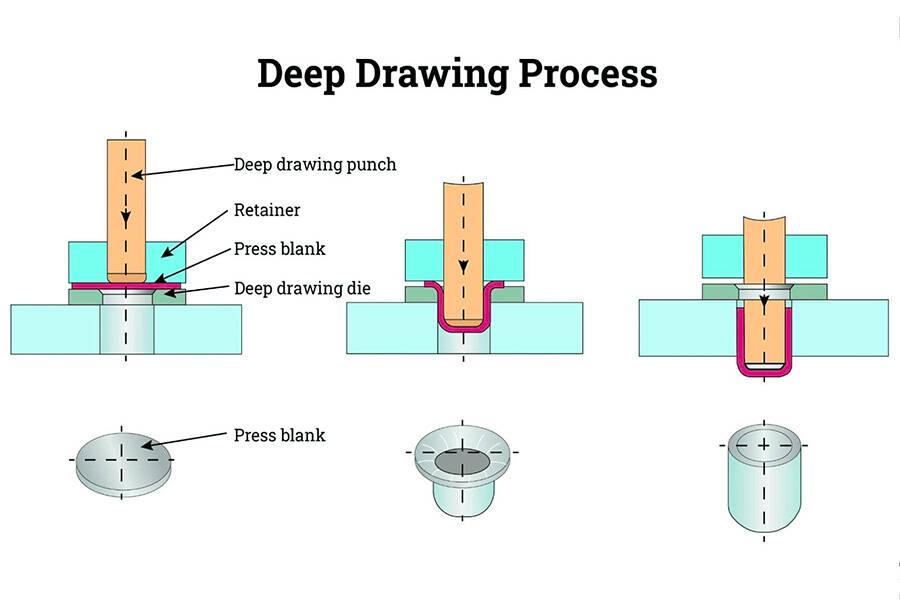Deep drawing stamping is an important metal forming processthat is widely used in the manufacturing industry, especially playing a key role in the production of complex, high-precision metal parts. This article will introduce in detail the definition, principle, process characteristics and application of deep drawing stamping in various industries.
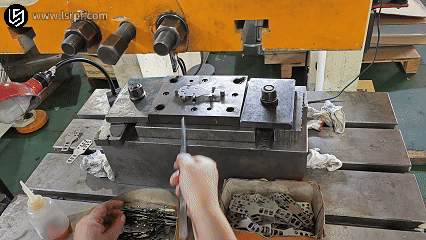
What is deep draw stamping?
Deep drawing stampingis a professional deep drawing forming technology that can process flat metal materials into seamless and hollow shapes. Different from other metal forming processes, the deep drawing stamping process guides the metal into the mold cavity and deforms it in a plastic state, thereby creating durable and high-precision bottom closed parts, such as cylinders or various shapes. Different cup-shaped parts. This efficient and precise manufacturing process plays a vital role in many industries, especially those that require extremely high component strength and precision.
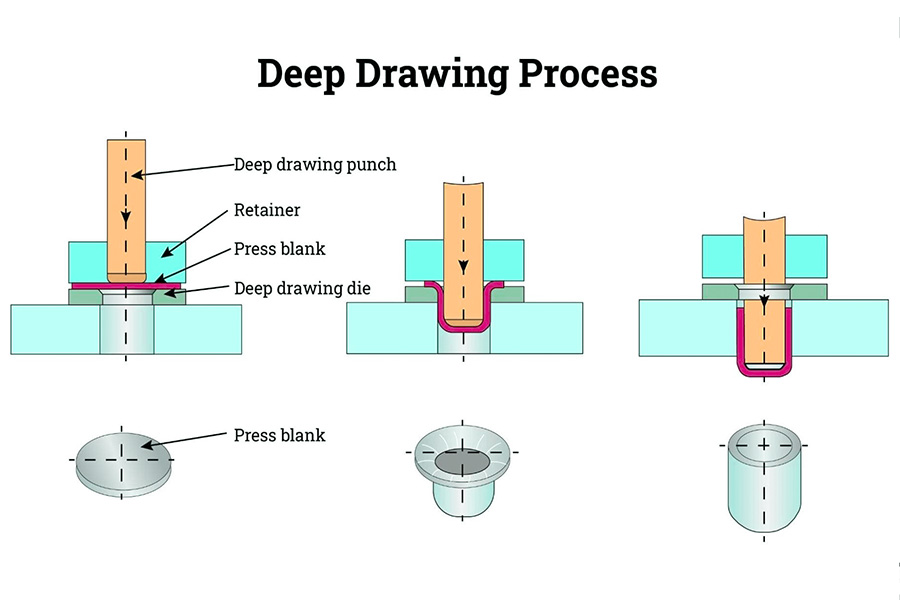
What are the advantages and disadvantages of deep drawing stamping?
Deep drawing stamping is an important metal forming process with a series of significant advantages and some disadvantages that need to be noted. The following table is a detailed summary of theadvantages and disadvantages of deep drawing stamping:
Advantages
| Merit | Description |
|---|---|
| High quality products | The deep-drawn stamping parts are made and assisted by molds in the processing process, so the shape and size of the processed products are very accurate. The service life of the die is long, and the deep-drawn stamping parts produced are high-end products in the market. |
| Wide range of applications | Deep drawn stamping parts are available in a variety of sizes and are precise in size, which can be applied to many fields of life and industrial production, such as household appliances and automobile manufacturing. |
| The production process is simple and easy | From the perspective of the overall control of the process, each step of the production process of deep-drawn stamping parts is controlled like an assembly line, so the complexity of human operation is much simpler than ordinary stamping methods. |
| Superior performance | Deep-drawn stamping parts have good performance in terms of tightness and internal strength, which can meet the needs of high-quality products. |
| Energy saving and environmental protection | Deep drawing stamping parts have a special manufacturing process, and many materials will be reasonably used in the processing process, and do not require too much energy consumption, saving energy and reducing production costs. |
Disadvantages
| Disadvantages | Description |
|---|---|
| Prone to defects | In the process of deep drawing and stamping, the parts are prone to defects such as wrinkles and cracks, which may be related to factors such as stamping process, feeding resistance of the pressing surface, contact of the pressing surface, lubricating oil use and slider adjustment. |
| There are requirements for materials | Deep drawing stamping usually uses metal materials with good ductility and plasticity, such as mild steel, stainless steel, aluminum alloy, etc. There are certain requirements for the selection and pretreatment of materials. |
How does deep drawing stamping work step by step?
Theprocess of deep drawing and stampingusually consists of a series of orderly steps designed to draw the flat sheet material through the die into the desired three-dimensional shape. The following is the generalprocess flow of deep drawing stamping:
- Material preparation:Choose appropriate metal plates as raw materials, such as stainless steel, aluminum, copper or mild steel, etc. Make sure the material is ductile and plastic enough to accommodate deformation during the drawing process.
- Blanking:Use a shear die or blanking die to cut blanks of the desired shape from the raw material. The purpose of blanking is to obtain the shape and size of the blank required for the deep drawing process.
- Sheet centering and cleaning and oiling:For automatic lines, center the sheet to ensure its accurate position. Clean the sheet to remove surface oil and impurities. Apply oil to reduce the friction between the mold and the material and improve the deep drawing effect.
- Deep drawing:Place the blank into thedrawing mold. The blank is stretched through the male and female molds of the mold to form the required three-dimensional shape. Deep drawing is a key process for stamping cover parts, and most of the shape of the cover parts is formed in the drawing process.
- Shaping:Shaping the parts that do not fully meet the requirements after drawing. The main content of the shaping process is to form the shapes that have not been formed in thedrawing processor to correct some shapes with high matching requirements.
- Trimming and punching:Cut off the process supplementary parts and surrounding corner materials on the drawn parts. Punch out the required mounting holes, reference holes, process holes and other holes on the parts.
- Flanging:Flanging the edges of certain parts to form the desired vertical edge shape. Flanging usually follows the trimming process.
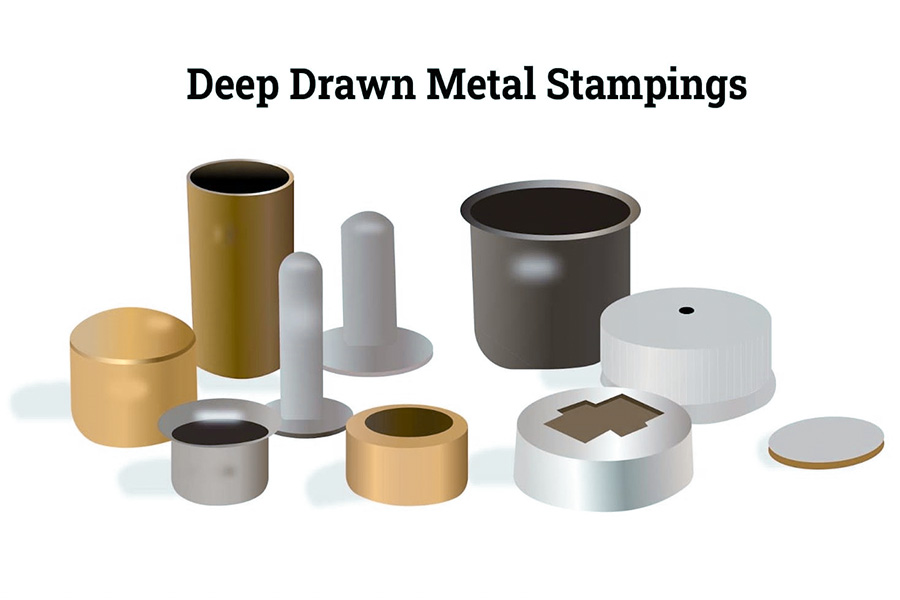
What are the applications of deep drawing stamping?
The mainapplications of deep drawing stampinginclude:
1.Aerospace industry:
Aircraft casings, engine components and other critical components are often produced using deep drawing methodsbecause of their precision and durability. For example, lightweight and high-strength materials such as aluminum-lithium alloy are used to manufacture aircraft wall panels, vertical tails and other components through deep drawing and stamping.
2.Medical industry:
Surgical instruments,medical device housings, implantable components, as well as syringes, insulin delivery devices, pacemakers and more often rely on deep drawing technology. These parts require high precision and the ability to be compatible with biocompatible metals, anddeep drawing stamping technologyensures product quality and safety.
3.Electronic products:
Battery casings,metal casings of electronic equipment, keyboards, connectors, etc. are all application areas of deep drawing stamping technology. These parts usually require thin walls, lightweight and high precision, and deep drawing stamping technology can meet these requirements and reduce production costs.
4.Household appliances:
From cookware to washing machine drums, casings, door panels and other components of home appliances such as refrigerators and air conditioners, many household items benefit from the deep drawing process. Deep drawing stamping can realize the integrated design of products and improve the aesthetics and practicality of products.
5.Packaging industry:
Packaging containers such as beverage cans and aerosol cans are usually manufactured using deep drawing and stamping processes. These containers require cylindrical shapes and smooth surfaces, which can be easily achieved with deep drawing technology.
6.Construction industry:
Aluminum alloy doors, windows, sunrooms and other building materials are also manufactured through deep drawing and stamping processes. Deep drawing stamping can achieve high strength and corrosion resistance of the product and increase the service life of the product.
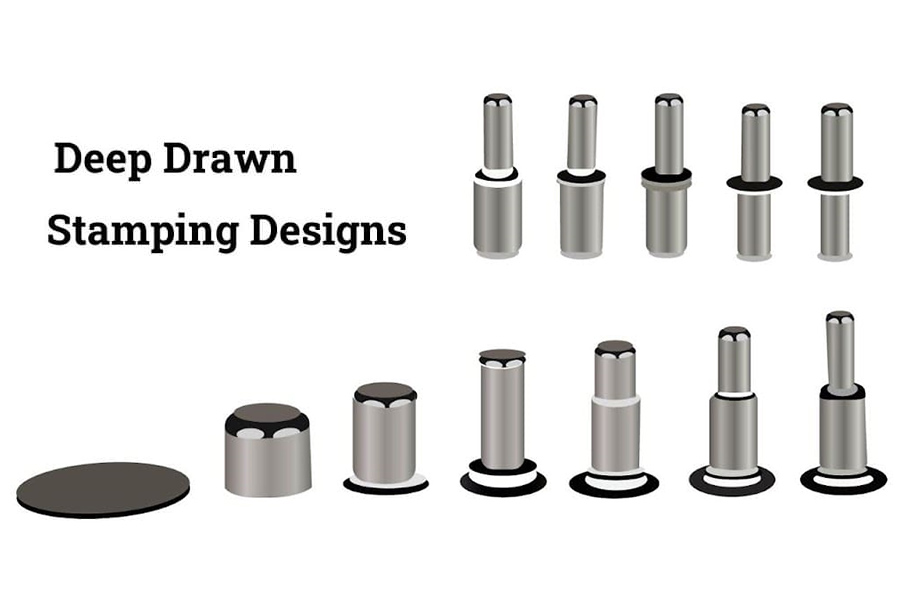
What are the challenges of deep drawing stamping?
Thechallenges of deep pull and stampingmainly include the following aspects:
- Material wrinkling:in the process of deep pulling, the material is affected by the tensile force. If the pressure edge force is not enough or the mold design is improper, it is easy to cause the material to wrinkle at the edge or some areas, affecting the quality and beauty of the parts.
- Material rupture:because the material is subjected to large stress during the stretching process, if the material strength is insufficient or the corner radius of the mold is too small, the material may rupture during the stretching process, resulting in an increase in scrap rate.
- Recovery problem:after unloading the mold for the deep-pulled parts, due to the elastic recovery of the material, the rebound phenomenon may occur, leading to the inaccurate size of the parts, and affecting the assembly and use.
- Difficulty of mold design and manufacturing:deep drawing stamping has high requirements on the design accuracy and manufacturing quality of the mold. The design of the mold needs to fully consider the fluidity and formability of the material. At the same time, the accuracy and wear resistance of the mold should be guaranteed in the manufacturing process, which increases the difficulty and cost of the mold design and manufacturing.
- Material selection and adaptability:the forming properties of different materials vary greatly, and the deep tensile stamping has high requirements on the plasticity, ductility and strength of materials. Choosing the suitable material and optimizing its shaping properties is an important challenge for deep tensile stamping.
- Process parameter control:the pressure side force, tensile speed, mold temperature and other process parameters should be strictly controlled to ensure the quality and forming efficiency of the parts. The precise control of these parameters requires highly the skill and experience of the operator.
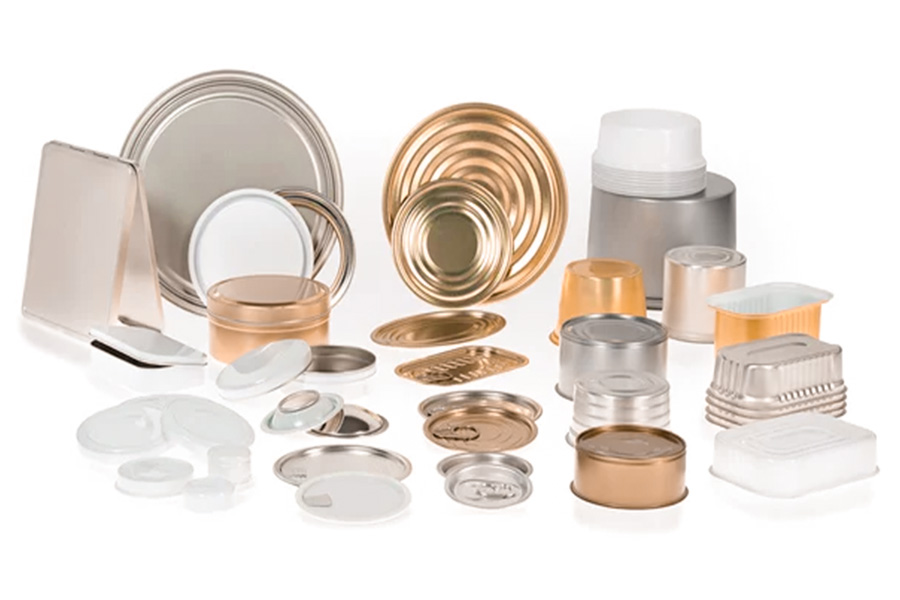
FAQs
1.What is deep drawing stamping?
Deep drawing is a metal plastic forming processthat forms a three-dimensional, usually hollow or cup-shaped part by placing a flat metal material in a mold and using pressure to stretch it radially and flow into the mold cavity. Deep drawing stamping is an important technology in metal forming and is widely used in automobiles, aerospace, electronics, medical and other fields.
2. What is the difference between deep drawing and deep drawing?
Deep drawing and deep drawing are similar in nature and both involve the process of stretching a flat metal blank into a three-dimensional shape. However, in the use of the term, "deep drawing" generally refers to a broader metal forming process that includes draw forming operations of various depths. "Deep drawing" focuses more on describing metal forming processes with larger drawing depths and more complex shapes. Therefore, it can be said that deep drawing is a special case or a more difficult application in the deep drawing process.
3.What materials are used for deep drawing?
Thedeep drawing processis suitable for a variety of metal materials, including mild steel, stainless steel, aluminum alloy, copper alloy, etc. These materials have good ductility and plasticity and can withstand large plastic deformations during the deep drawing process without cracking. The specific choice of material depends on factors such as product design requirements, use environment, and cost.
4.What is the deep drawing process?
The deep drawing process is a metal plastic forming technology that involves placing a flat metal blank in a mold and stretching the metal sheet into the desired three-dimensional shape through the synergy of the punch and the mold. This process usually includes multiple steps such as stamping, drawing, trimming and possible post-processing steps to achieve the final product shape and quality. The deep drawing process is widely used in many industries due to its efficiency, flexibility and ability to produce parts with complex shapes.
Summary
Deep drawing stamping, as an efficient metal forming process, plays an indispensable role in the manufacturing industry. Not only does it produce complex, seamless parts, it also offers cost-effectiveness, production flexibility and a high-quality surface finish. With the continuous advancement of technology and the in-depth expansion of applications, deep drawing stamping will continue to contribute to the development of the manufacturing industry in the future.
Disclaimer
The content on this page is for reference only.LSdoes not make any express or implied representation or warranty as to the accuracy, completeness or validity of the information. No performance parameters, geometric tolerances, specific design features, material quality and type or workmanship should be inferred as to what a third party supplier or manufacturer will deliver through the Longsheng Network. It is the responsibility of the buyerseeking a quote for partsto determine the specific requirements for those parts.Pleasecontact usfor moreinformation.
LS Team
LS is an industry-leading companyspecializing in custom manufacturing solutions. With over 20 years of experience serving more than 5,000 clients, we focus on high-precisionCNC machining,sheet metal fabrication,3D printing,injection molding,metal stamping,and other one-stop manufacturing services.
Our factory is equipped with more than 100 advanced 5-axis machining centers and is ISO 9001:2015 certified. We provide fast, efficient, and high-quality manufacturing solutions to customers in over 150 countries worldwide. Whether it’s low-volume production or large-scale customization, we can meet your needs with delivery as fast as 24 hours. ChoosingLS Technologymeans choosing efficiency, quality, and professionalism.
To learn more, please visit our website:www.lsrpf.com


